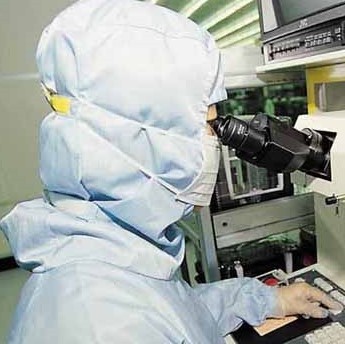ASML's China business endangered by US sanctions
The Dutch maker of semiconductor fab equipment risks being cut off from the lucrative Chinese market by Joe Biden's latest moves.

The collateral damage from Joe Biden's latest assault on Chinese technology may extend right into the Dutch town of Veldhoven. ASML, its most famous company resident, owed much sales growth to Chinese business when it published financial results for the first half of this year, deriving nearly a sixth of its revenues from China. All that could fade more quickly than a snipped tulip after the US announced sweeping restrictions last week designed to cripple China's technology industry.
The legislation cuts Chinese companies off from various semiconductor technologies, tools and software, including the equipment that goes into factories. US dominance makes it a powerful weapon. Although semiconductor production is today concentrated in Asia, American firms remain at the forefront of chip design. They are also largely responsible for the machinery and software used in semiconductor production. Applied Materials, Lam Research and KLA Corp, three prominent US makers of fab equipment, will all be hurt by the new rules.
But ASML is another likely victim. The Dutch company specializes in lithography, the hi-tech process of etching mazy lines of microscopic circuitry into silicon wafers. Today, it monopolizes an advanced form of the technology known as extreme ultra-violet lithography (EUV). ASML's EUV machines are used in the manufacture of cutting-edge chips with transistors that measure as little as seven nanometers (billionths of a meter) or less. But they are not sold to China, despite ASML's best efforts.
Figure 1:  Testing times for the chip industry: Taiwanese foundry TSMC has cut its capital expenditure forecast this year by $4 billion, to $36 billion.
Testing times for the chip industry: Taiwanese foundry TSMC has cut its capital expenditure forecast this year by $4 billion, to $36 billion.
(Source: TSMC)
The reason stems from something called the Wassenaar Arrangement. Featuring 42 signatories from democratically elected governments, it is intended to restrict the sale of technologies with dual civil and military uses. When ASML asked for an export license to sell EUV machines to SMIC, a Chinese fab, the Dutch government rejected its application, believing this would contravene the Wassenaar Arrangement. Lobbying by US officials in the Trump administration – then determined to restrict the flow of advanced chips to Huawei, a Chinese maker of smartphones and network equipment – is likely to have been a factor.
DUV down
The question now is whether even tougher US sanctions put sales of other products at risk. While stopped from selling EUV machines to China, ASML has been able to supply equipment based on deep ultra-violet lithography (DUV), an older form of the technology that still accounts for the bulk of ASML's revenues. For the first half of this year, ASML recognized revenues for just 15 EUV systems but as many as 127 DUV ones. China, as shown by ASML's sales figures, is a big DUV market.
Using those DUV tools, SMIC was apparently able to produce a relatively unsophisticated seven-nanometer chip earlier this year, according to research carried out by TechInsights, an analyst firm. If the DUV technology was not sold by ASML, it would have had to come from either Canon or Nikon, Japanese DUV rivals that lack ASML's EUV expertise. Japan, however, is also signed up to the Wassenaar Arrangement. And ASML's efforts to supply EUV technology to SMIC means suspicion naturally falls on the Dutch company.
At the time of writing, ASML had not responded to a question about the danger posed by the latest US sanctions. But analysts have voiced alarm. Richard Windsor, a former analyst at Nomura Securities who today runs Radio Free Mobile, noted in a recent blog that some of ASML's core components are supplied by US companies, which "could mean a complete suspension of sales to China in all of the equipment that it sells." Already, he points out, "ASML has ordered its US staff to stop dealing with all of its Chinese customers."
Want to know more about 5G? Check out our dedicated 5G content channel here on Light Reading.
Trading on the Nasdaq, ASML's share price fell about 6.5% on Friday as investors weighed the implications of the US moves for the Dutch company. Sales to China rose 19% for the first half of 2022, to nearly €1.3 billion (US$1.3 billion), compared with the year-earlier half, while group sales were up just 7% over the same period. During a call with financial analysts in July, CEO Peter Wennink said he was counting on China sales to grow a tenth this year, noting China's criticality to the DUV sector.
"I think we need to realize that China is an important player in the semiconductor industry and especially in the more – let's say not mature nodes but in the more mainstream semiconductors," he said. "It's everything that has to do with deep UV, yes … And they're a very significant supplier of the global markets."
More boom and bust
Before last week's news, experts who track ASML were already worried about rising inflation and the possibility of a slump in demand next year as a recession bites. Both issues were acknowledged by Wennink back in July. Freight costs had "gone through the roof," he said, while labor costs in Asia were up 20% this year. "There is clear concern in the market regarding recessionary fears and the impact this could have on demand," said Wennink. "Of course, if we were to go into a significant recession, we would not be immune to this, but we don't expect our 2022 business to be impacted."
In his blog, Windsor said various semiconductor players had already reacted to the tightening of US sanctions by slashing outlook, with TSMC, a huge Taiwanese foundry, cutting its capital expenditure forecast this year by $4 billion, to $36 billion. "This is a big cut as one would have expected it to have already spent a good portion of the $40 billion," said Windsor.
Regardless, some observers have warned a capacity glut could swiftly replace the semiconductor shortages of the last year. Like many other stakeholders in the chip industry, ASML insists demand will be much higher in future as the planet becomes even more dependent on technology and a genuine "Internet of Things" takes shape. But the industry has been through numerous boom-and-bust cycles before. For many semiconductor firms, next year could be more of the familiar.
Related posts:
— Iain Morris, International Editor, Light Reading
About the Author(s)
You May Also Like




.jpg?width=300&auto=webp&quality=80&disable=upscale)







